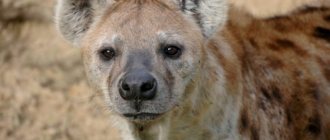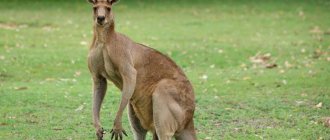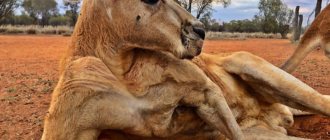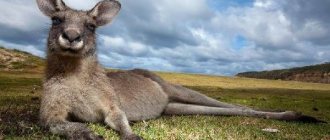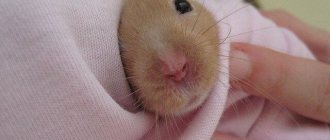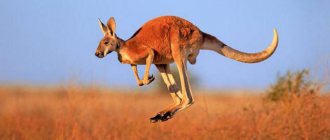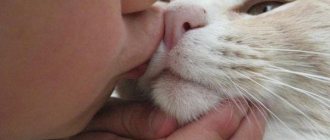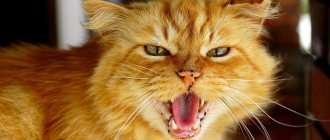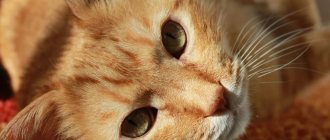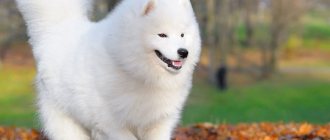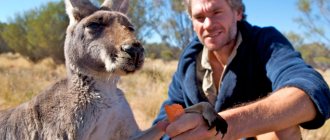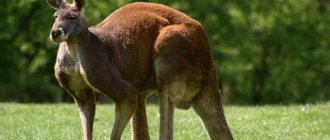The word "kangaroo" translates as "I don't understand you."
Many of us are well aware of where the name of this wonderful animal came from.
Thus, according to the widespread version, the members of Captain Cook's expedition first saw a kangaroo and were amazed by the appearance of this strange animal, which also jumped, pushing off with its long hind legs. In addition, a small cub was peeking out of a large pocket hanging on the animal’s belly. "What kind of animal is that?" - the stunned Europeans asked the local residents. They answered: “Ken ge roo” (kangaroo). Since then, this wonderful animal has been called a kangaroo. And only many decades later the settlers realized that in the language of the indigenous people the word “kangaroo” means “I don’t understand you.” However, modern linguistic research does not support this cheerful version and claims that it is just a popular myth. According to them, the name kangaroo comes from the word “kangurоо” or “gangurru”. This is the name of this animal in the Guugu-Yimidhirr language of the Australian aborigines (the language of the Pama-Nyung family) and it was this name that was heard by the first Europeans who landed on the Australian coast.
A little history
Kangaroos live in only one country in the world, Australia. These animals are so unique and mysterious that their discovery and name have several different versions. Today, almost everyone knows the name of the animal with a long tail and a pocket on its stomach. But the first Europeans who entered the territory of the remote continent were very surprised by the appearance of this animal. Trying to find out from the natives what kind of creatures they were, they only received “kangaroo” in response. This name stuck, and this is how those first travelers introduced this animal to the old world. However, the answer of the aborigines did not mean the name of these animals at all. According to one version, the word “kangaroo,” or rather a combination of words, meant “I don’t understand.” According to another version, this word meant another marsupial animal - a wallaby.
It is impossible to say for sure who was the first European to see this interesting animal. But it is generally accepted that this word was brought to Europe by the famous navigator James Cook. However, there is a version that a century and a half before Cook told the whole world about this animal in 1770, a kangaroo was seen by the Dutch traveler Frans Pelsaert, who, due to various unforeseen circumstances, was forced to stay in Australia for a long time and even, according to some sources, tried to use kangaroos in domestic animal husbandry.
Kangaroo and man
Kangaroos as such, of any kind, live quite freely. They move freely and quite often destroy crops and pastures. In this case, operations are usually carried out to reduce the number of herds. In addition, many large kangaroos are exterminated for their valuable fur and meat. The meat of these animals is considered healthier than beef or lamb.
The increase in the kangaroo population was the creation of kangaroo farms. Kangaroo meat is eaten not only in Australia, but throughout the world. This nutritious product has been supplied to Europe since 1994. This is what packaged kangaroo meat sold in supermarkets looks like.
Moreover, according to the recommendations of several leading Australian scientists, kangaroo breeding in Australia can be increased tens and even hundreds of times.
Research has proven that the manure of ruminant animals, such as sheep and cows in Australia, when decomposing, emits strong greenhouse gases - methane and nitric oxide. These gases contribute hundreds of times more strongly to the greenhouse effect than carbon dioxide, which was previously considered the main culprit of global warming.
Currently, the huge number of livestock raised in Australia means that methane and nitrogen oxide account for 11% of all greenhouse gas emissions from Australia. Kangaroos produce incomparably less methane. Therefore, if you breed kangaroos instead of sheep and cows, this will reduce greenhouse gas emissions into the atmosphere by a quarter. If, over the next six years, 36 million sheep and seven million cattle were replaced by 175 million kangaroos, this would not only maintain current levels of meat production, but also reduce annual greenhouse gas emissions by 3%.
Researchers claim that using kangaroos for meat production can be used all over the world, and this will not only provide a new way to feed the world's population, but will also reduce the greenhouse effect and, as a result, reduce global warming. However, there are certain difficulties in this. A significant cultural restructuring and, of course, considerable investment are needed. One of the significant problems in resolving this issue is that the kangaroo is the national symbol of the country; it is depicted on the state emblem of Australia. In addition, environmentalists oppose this use of this animal.
Varieties
To date, scientists have established that there are about 50 species of kangaroos. They can all be divided into three groups: the smallest are kangaroo rats, the medium ones are wallabies and the most famous are giant kangaroos. This animal is so popular that it is a symbol of Australia. The kangaroo, along with the ostrich, is depicted on the national coat of arms.
Giant kangaroos, in turn, are also divided into three species. The largest of them are gray kangaroos. They are also called forest species due to their respective habitat. These kangaroos are the friendliest and most trusting of the entire family. These animals can reach three meters in length.
Red kangaroos, also known as steppe kangaroos, are slightly smaller in size than their gray counterparts. However, this type of kangaroo is the most common. They can easily be found on the outskirts of almost any Australian city.
The smallest representatives among this species are mountain kangaroos. They are also called wallaroo. People learned about them later than everyone else, since they live in remote mountainous areas and their numbers are small. These kangaroos have the most harmful character. It can be quite difficult to tame them.
Offspring
Surprising is the fact that the cubs of these rather large animals are born very small. Their size is several tens of millimeters. In relation to the size of the mother, the cubs of these animals are the smallest among mammals.
For a long time, the answer to the question of how little kangaroos end up in their mother’s pouch has been a mystery to scientists. It was assumed that the mother lifts the baby with her teeth and, straightening the pouch with her forelimbs, places it there. There was also a hypothesis according to which the baby is born already in the pouch. However, it was later found that immediately after birth, the tiny cub independently climbs into the mother's pouch.
This fact was established during detailed observation of kangaroos in captivity and, in particular, the progress of pregnancy. By the way, it lasts one month. Immediately before giving birth, the female sits down and begins to lick the belly and the pouch itself. Almost immediately after birth, the tiny cub climbs up its mother's fur on its own to get into the pouch, where it will spend the next eight months.
The pouch itself is the prerogative of females; male kangaroos do not have one. The bag contains four nipples, to one of which the newborn is attached. By the way, each nipple feeds the baby with different milk, depending on his age. A female kangaroo can also provide two babies of different ages with different milks at the same time.
All this long time, while the cub is in the pouch, the mother looks after it and makes sure that it does not get out of there ahead of time. To do this, she contracts the muscles at the top of the bag. When the baby gets out, he still periodically climbs into a warm and safe bag for some time.
Myths of the Titanic. Part 5
1. Locked passengers 3rd class
Bostwig grilles for deck G
First you need to understand the practice of the courts of that time. Among the 3rd class passengers there were many emigrants who could be suffering from one or another disease. It was precisely to prevent it from spreading to passengers of other classes that these bars were installed, and not because of “class hostility.” These gates were kept either closed all the time or open, but with guards. When the collision with the iceberg occurred, it is logical that it was the 3rd class passengers who were at the very bottom who rushed up first. Seeing that passengers want to go where they are prohibited from going, the guards close the bars, as this is their duty.
The trouble is that no one knows the real situation, that the ship will actually sink. When this finally became clear, the gates began to open. But those many gates that were initially closed and unguarded remained closed.
Ideally, the passenger should not have waited with the crowd for the opening of the gate (which was locked by guards who were unaware of the real situation) on one of the gangways, but used another. But they waited too long, until the full disastrous situation became clear to everyone, both guards and passengers. But it was already too late.
2. Replacing the Titanic with the Olympic to obtain insurance
Olympic and Titanic in Belfast, March 1912
For those who don’t know, a total of 3 ships similar to the Titanic were created: Olympic, Titanic and Britannic. It was a series of three transatlantic liners built as flagships according to the Olympic class project.
On September 20, 1911, the Olympic collided with the cruiser Hawk. As a result, the Olympic received serious damage and was sent for repairs. According to one conspiracy theory, she was experiencing major financial problems. Therefore, she decided to improve her financial situation and arranged this incident. However, they lost the case and were not paid the insurance. And supposedly then, a brilliant decision was made - to quickly replace the Titanic with the Olympic and send it along a dangerous route full of icebergs so that it would run into it. Then the company would receive insurance, and at the same time prove the unsinkability of the ship.
There are a huge number of refutations of this theory. Although these ships were “twin brothers,” they had a large number of differences. Here is a list of the most notable of them:
Differences between Olympic and Titanic
Here you can also include a myth that on April 14, exercises on boarding people in boats and lowering them were supposed to take place, but for some unknown reason they were canceled. This fact really took place, but with one “but”. The exercises were canceled for a reason, but because of bad weather.
Lifeboats of the Titanic. View towards the nose
At that time, the focus in the construction of ships was not on lifeboats, but on the survivability of the ship, which was achieved with the help of watertight bulkheads. The British Ministry of Trade believed that even if they had the required number of boats, they would still not be able to be lowered if the ship did not have watertight bulkheads. And not to say that they were wrong. And in order to encourage companies to install waterproof bulkheads on their ships, they came up with a rule according to which if these same bulkheads are on the ship, then the number of boats on board can be reduced. There was also a special table for determining their quantity based on the tonnage of the vessel. So, according to this table, only 16 boats were supposed to be installed on the Titanic. But, as you know, there were 20 of them installed on the Titanic. That is. even more than was necessary according to the rules.
It is worth saying that even if the Titanic had the required number of boats, they would hardly have been used. After all, that night they didn’t even have time to release those that were available.
But this is really sad. For many years people have been waiting for the second Titanic to be built. Now, one Australian billionaire says he's finally ready to do it.
In 2012, Clive Palmer announced that he was going to build a copy of the famous Titanic liner - Titanic II. Original drawings were to be used and the ship was to be almost a complete copy of its famous predecessor, but more modern and safe.
Nutrition
Kangaroos feed mainly on grass. They feed at different times of the day, depending on the temperature. In hot weather, they can spend the whole day in the shade, and only go out for food at night. Kangaroos are very undemanding when it comes to water. They can live without it for a whole month. Wallaroos may be cut off from water for an even longer period of time. In extreme cases, they strip the bark from trees and quench their thirst with the secreted plant juice.
About minerals. No. 7
Place of Birth:
Russia, Africa, Kazakhstan, Germany, USA, France, Australia, Afghanistan.
Story:
Azurite was first mentioned in the works of Aristotle and Pliny the Elder. In Ancient Egypt, azurite was considered a sacred stone. It was used in rituals of communication with the gods. In the East, azurite was also credited with magical properties associated with clairvoyance. In 1824, F. Bedan, a well-known mineralogist in his time, gave the stone its modern name, azurite.
Note:
Despite the similarity of names, azurite and lapis lazuli have completely different chemical compositions. Azurite is a compound of copper, and lapis lazuli is a compound of aluminum, sodium and calcium.
(photo of my samples)
Enemies
In the wild, kangaroos conflict with small midges, indigos, foxes and birds. Midges lie in wait for them in watering places and accumulate in large quantities in the area of the kangaroo's eyes. Very often, due to their bites, kangaroos go blind. The rest of the ill-wishers pose a danger to the little kangaroos. Kangaroos skillfully defend themselves from enemies. They can strike with both front and hind limbs. Moreover, the hind legs are not only very strong, but also pose a serious threat due to their sharp claws. They strike with the hind limbs of the kangaroo resting on the tail. Its size and flat vertebrae allow this to be done without difficulty.
Today you can watch these amazing animals almost everywhere in zoos. Moreover, there they are so tamed that they are even allowed to be fed to visitors, but only with special food.
Myths of the Titanic. Part 4
1. The last photo on the Titanic
Many articles about the Titanic like to use this photograph and say that it was taken almost minutes before the disaster. But in reality this is far from the case.
Firstly, in appearance the photograph does not resemble any public place on the Titanic. Ceilings too high and wooden floors.
Secondly, all known photographs of the inside of the Titanic were taken by Father Brown. And he got off the ship in Queenstown on April 11th.
Well, the most important thing. It is known where and when this photo was taken. It first appeared in The Eastern Morning News in December 1911. The article stated the following:
As it turns out, this event took place at Burton Constable Hall, in Yorkshire. So there can be no question of any “Titanic”. In fact, you can still visit this mansion today. This is what this house and the room in which the photograph was taken look like today:
Burton Constable Hall
And here is the hall itself from the photo:
2. Due to panic, the boats set sail half empty
Lifeboat No. 6. It can be seen that it is far from completely filled.
Not so often, but still a fact that occurs, which is not exactly a lie, but cannot be considered completely true either. Perhaps why the boats did not leave completely full was due to several reasons.
Firstly, people thought that it was much safer on board such a large liner than in a small boat. First class passenger Duff-Gordon, who survived in lifeboat No. 1, later recalled:
“I will never forget how black and bottomless the ocean looked below us, and how I didn’t want to leave the big, cozy ship and get into a fragile, small boat.”
Secondly, in fact, no one on the team really knew how to act in this situation. Each boat was assigned people responsible for it, but few people studied this list. And although the exercises were held in Southampton, this was obviously not enough. Also, the officers were not sure that the davits would support a boat completely filled with people, and therefore did not fill it completely.
Below is the chronology of the launch of the boats:
It shows that the situation is not so bad, and that the boats located closer to the bow were mostly half empty. Perhaps this is due to the fact that they were the ones who were lowered first. And only when the nose began to go under water, the terrible truth began to be revealed to people, and they began to realize the full misery of their situation. Because of the panic that arose, the ship's crew even had to create a barrier out of themselves so that not all people could get through.
Obviously, it was precisely because of the panic that more people were saved.
To summarize, we can say that the boats left half-full not because of panic, but quite the opposite, thanks to confidence in the unsinkability of the ship. And only the crew of the ship, and later the fear of death, forced people to take their places in them.
3. The Baker Who Survived on Alcohol
There is a legend that one cook drank a whole bottle of brandy before jumping into the water. Due to this, he stayed in cold water for an hour and survived. However, as you probably already guessed, not everything here is as clean as it seems at first glance.
In case you didn't know, alcohol does not warm the body. It only creates the illusion of warmth by dilating the blood vessels. This, in turn, only aggravates the situation of a person caught in icy water. A drunk person only loses heat faster than a sober person.
Well, as for the culprit of this myth, he was not a cook, but a baker and his name was Charles Jufin.
And the miraculous salvation of our hero was influenced by several factors:
